

|
Home Updates Hydros Cars Engines Contacts Links Contact On The Wire |
|
|
Mark Osborne 'For The Cost of Speed' May 2014 |
The 2 most asked questions in the world of Tether Car racing –
1. "How fast does it go mister?" and
2. "What does one of these things cost?"
The first question is unpredictable; the second depends on how fast you want to go.
Starting off with building a car. As noted in "View from the pylon" May 2014 for sources of parts for cars or completed cars for enthusiasts to race are becoming more scarce. With the advent of internet auction sites some vintage style car prices are costly and usually go to "shelf racers", and WMCR A Grade cars are like Rocking Horse doings and are non-existent unless you know someone or someone is upgrading to a new car, i.e. (the car they are selling has reached its upper limits in development).
So where do we start? It could be a catch 22 situation – you buy the engine to fit the pan (chassis) or you buy pan to fit the engine. This article primarily relates to a WMCR Class V, 10cc A Grade car with sourced (bought) and workshop made parts that I have built this year, so this is one of the latest up to date cars for 2014.
After World Championships in Basel in 2013 and discussions with Glenn Bransby and seeing Margaret James' new car we decided to "bite the bullet" and have a go at a Class V car. Being brought up on Class IV 5cc cars Glenn and I thought it wouldn’t be too difficult, but I understand that if you are starting out afresh in the hobby it could be a daunting task.
We started off after the World Championships, after discussion with a lot of the suppliers of parts we ordered a lot of parts from Marino Vavassori in Italy, an 8th edition Picco 60 engine from Paul Otto Strobel in Switzerland, a set of rear wheels and some sets of tyres from Horst Denneler in Germany.
The 7 series aluminium alloy billet pan and rear pipe and shock absorber bracket was sculptured with a CNC program designed and made by David James, as was the Carbon Fibre top. The front suspension was made using my Eastern Havco AL50G lathe and BF 20L Vario milling machine out of 7 series aluminium.
Don’t be disillusioned that this is a hard build, all it takes is careful planning, research, patience and a lot of fettling ("old world" word not used in 21st century of throw away products – for trimming or making ready according to Oxford Concise Dictionary)

David James CNC designed and made 10cc A grade, 7 series, aluminium billet pan
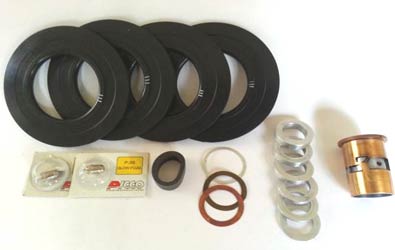 |
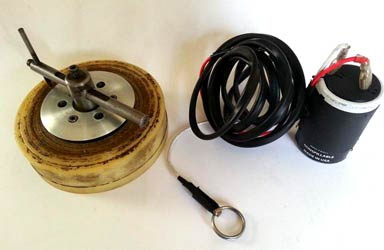 |
Along with the components for the build one needs a hoard of spare parts for upkeep and breakages including tyres, Picco P3S hot filament glow plugs or equivalent, head and liner shims, exhaust rubbers, spare pistons and liners, exhaust pipe spacers, also every day running equipment, tyre-cutter, remote battery for glow plug, Methanol/Castor Oil Fuel Mix.
Breakdown of Parts, Suppliers and Costing
|
Supplier |
Item | Cost in Euro | |
| Australia: David James | Pan, top and pipe/shock bracket | 1100 | |
| Switzerland: Paul Otto Strobel | Picco 60 8th Edition engine | 760 | |
| Italy:
Marrino Vavassori
|
Gearbox 1.53 ratio
& fitting kit Billet Fuel Tank & fitting kit Fuel Shutoff Front & Rear Shock Absorbers Rear Shock Absorber Kit Exhaust Pipe and Clamp Titanium Pan Handle Engine Flywheel Front Wheels |
575 238 185 85 45 280 280 190 35 |
|
| Germany: Horst Denneler | Rear Wheels Tyres Pair |
110 18 |
|
|
Incidentals |
High Tensile Screws |
50 | |
| Prices as at May 2014 |
Total Euro |
3591.00 | |
Running Costs/ Spares
| Fuel 5 litres Glow Plug / Each Rear Tyres /pair Picco Beryllium Piston/Liner 2 volt Sealed –Lead Rechargeable Battery and Charger Various Head & Liner Shims |
17 5 13 190 51 25 |
|
|
Prices as at May 2014 |
Total Euro |
301.00 |
|
Other small incidentals sourced or made were front spring for suspension (paint spray gun spring) which is really hard to judge and trial and error fitting of different spring loadings can only be perfected once car has been run. Front and rear suspension pivot axles were made from 4mm piano wire and front suspension 4x11x3 flanged bearings were used. Tail skid was made from tungsten carbide parting tip epoxied into rear of body. Problems arising from sourcing from different suppliers were only the PCD on one side of the gearbox wheel mounting holes were different to the gear side by 1mm? Rectified by re-drilling one wheel hub. First run trials were carried out in January 2014 with speed of 316 kph. A problem with front spring vibrating off pad mount required 3mm screws inserted top and bottom in pan and front suspension to remedy, with screw heads tight fit in spring. A continuous problem, as with a lot of Class V cars is loss of body screws (no matter how hard you tighten them). After 20 runs the piston decided to become holey and required my last piston and liner. I was assured that the piston material (from NZ) was between 26 and 28% silicon content but who knows what you get nowadays! Fastest speed to date is 327 kph. Next month, the rebuilding and tribulations of "Sharkie", a 1970’s vintage 10cc C grade. Mark Osborne can be contacted by email at mark.osborn1@bigpond.com |
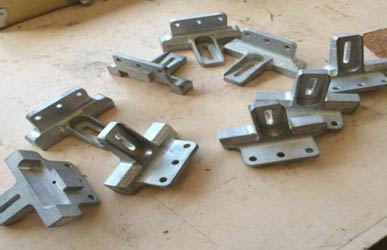 |
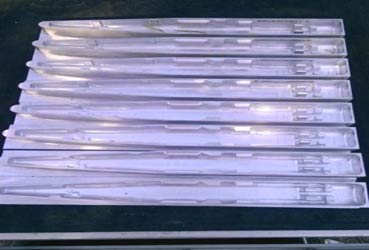 |
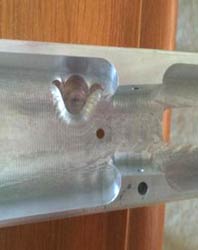 |
| Pipe and rear shock brackets | 8 pans fresh from CNC machine | Front spring keeper pad |
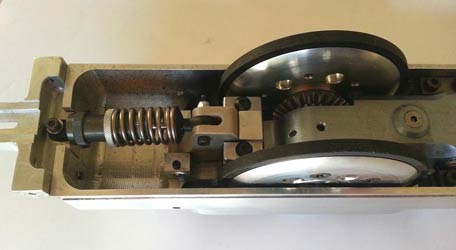 |
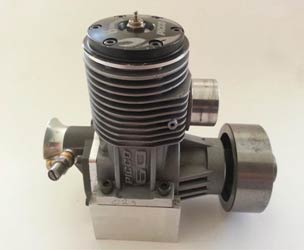 |
| Rear suspension set up. Note plastic suspension swivel. | Picco 60 8th Edition engine |
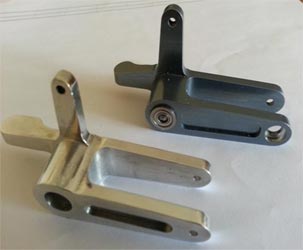 |
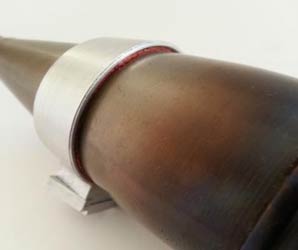 |
| My own Front Suspenion compared to Picco (rear) | High temp silicon used to absorb Shock
between pipe and mount |
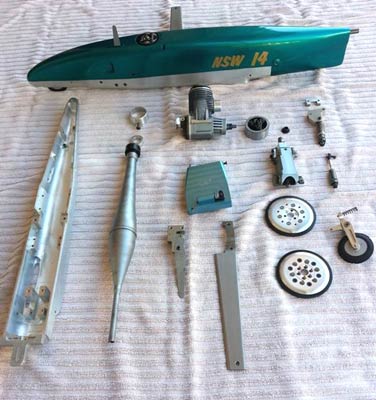 |
Left: Completed car and all components to build a car Pan numbers DCO 1 & 3, 2 new cars ready for 2014 season down under |
Mark Osborne can be contacted at – mark.osborn1@bigpond.com
Calendar and results from Sydney
and Brisbane
www.trcaa.org
Sydney Society of Model Engineers inc
www.ssme.org.au
©copyrightMarkOsborne2014